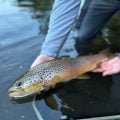How to Tie a Lightning Bug
Producer: Tim Flagler
The Lightning Bug was developed by Larry Graham of Washington State in the early 90s. It’s one of those flies that has spawned a ridiculous number of variations throughout the years. For whatever reason, I’ve always considered it a summer prospecting pattern but recently found out that it also works surprisingly well during the winter.
For this Lightning Bug, I’m going to use a Fulling Mill 50 85 nymph hook in size 14. I like to first get hold of the hook with plunger-style hackle pliers. I’m going to pair the hook with a 7/64” nickel-colored tungsten bead. Feed the point of the hook into the small hole of one of the beads. You can then get the assembly firmly secured in the jaws of your tying vise.
For thread, I’ve loaded a bobbin with a spool of white UTC 70 Denier. Get the thread started on the hook shank at the back edge of the bead and, after taking a few wraps rearward, snip off the excess tag. Then wrap your thread forward and leave it at the back edge of the bead.
.015 lead-free wire is used to add some weight and to help stabilize the bead. Insert the bitter end of the wire into the back of the bead and push it all the way forward. Start taking thread wraps to anchor the wire to the top of the hook shank. Take wraps with the wire behind the thread, 4-5 rearward turns should be plenty. Anchor the wire to the top of the hook shank with thread wraps. Once the wire is on top of the shank, rock it up and down as you take thread wraps rearward. The wire should break, leaving a small ramp down to the hook. Return your tying thread first to the back edge of the bead, then down the shank to the end of the wire wraps.
Small, silver Ultra-wire is used to rib and segment the fly, a 10” length will make numerous Lightning Bugs. Straighten out one end and butt it against the wire wraps on the near side of the hook. Take thread wraps to secure it there. Keep binding the wire to the near side of the hook, all the way back to the start of the bend. Return your tying thread to the back end of the original wire wraps.
Natural pheasant tail fibers are used for both the tail and legs of the fly. For the tail, pull down 5 or 6 nicely tipped fibers, perpendicular to the stem and strip them free. Cutting off the curlies is always a good idea. Get hold of the fibers by their tips, in the fingers of your right hand. Measure to form a tail about a hook shank in length and transfer that measurement rearward to the start of the bend. Now, grip the fibers and the hook shank with the fingers of your left hand, and reach in with your scissors to snip the butt ends of the pheasant tail fibers off, even with the back edge of the wire wraps. Give your bobbin a counterclockwise spin so the first thread wrap will want to jump rearward and catch the very ends of the fibers. Continue taking thread wraps rearward, binding the pheasant tail to the top of the hook shank as you go. When you reach the start of the hook bend, wrap forward and leave your thread just behind the back edge of the bead.
I like medium-sized silver Holo tinsel for the body of the fly, but regular silver tinsel will work as well. A 10” length is enough to make a couple of Lightning Bugs. Place one end of the tinsel against the near side of the hook and take thread wraps to secure it. Begin taking touching wraps rearward with the tinsel, all the way to the base of the tail, then overlapping wraps forward to behind the bead. When you get there, anchor the tinsel with a few tight turns of tying thread and snip the excess off close.
Get hold of the silver wire and start making open spiral counter wraps with it over top of the tinsel body. When you reach your tying thread, use it to anchor the wire, then helicopter to break it off close.
Large, opal-colored Mirage tinsel is used for the fly’s wing case. A 10” length is generally enough for four flies. Secure one end of the tinsel to the top of the hook, behind the bead, and bind it down to a point about 1/3 of the way down the shank. Leave your tying thread at that 1/3 point, which will be the back edge of the wing case.
For the fly’s legs, pull down 8-10 pheasant tail fibers, perpendicular to the stem, and strip them free, doing your best to keep the tips aligned. Here too, it’s a good idea to snip off the curlies. Get hold of the tips of the fibers with your left hand then place them on top of the hook shank so they extend about 2 bead-lengths past the front edge of the bead. Take wraps of tying thread to secure them there. Do your best to separate the fibers equally on either side of the hook. This can be a little fiddly, but it’s not that hard to do. With the tips separated, lift up the butt ends of the pheasant tail fibers and snip them off close.
Two peacock herls are used to form the thorax of the fly. Snip about an inch of their brittle tips off square. Place the snipped-off ends against the near side of the hook and take thread wraps to secure them rearward to the back edge of the wing case. Leave your thread right there and start taking wraps with the herls behind it. Pushing up on the thread will help to keep the herls sandwiched together. At the back edge of the bead, use your tying thread to firmly anchor the herls, and snip the excess off close.
Bring the Mirage tinsel forward, over top of the thorax and pull it tight. As you do this, sweep the pheasant tail legs rearward on either side of the fly. With the legs pushed back, take a few wraps of tying thread to anchor the tinsel. Fold the remaining tinsel rearward and bind that down with wraps of tying thread, so there’s no way it can pull free. Once the tinsel’s anchored, snip the excess off close. The wing case and legs should now look something like this. Reach for your whip finish tool and use it to do a 4 or 5 turn, back to front whip finish, then seat the knot well and snip or cut your tying thread free.
A drop of head cement or here, Sally Hansen Hard as Nails, applied to these thread wraps will ensure they don’t come unraveled. Once the adhesive dries, your Lightning Bug is ready to fish. I have a strange feeling that this flashy little pattern actually works quite well, pretty much year round. It’s probably a good idea to always have a few on hand.
How to Tie a Light Cahill Parachute (with a twist)
How to Tie a Little Black Stonefly











